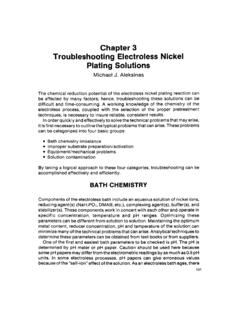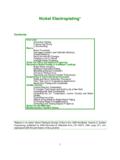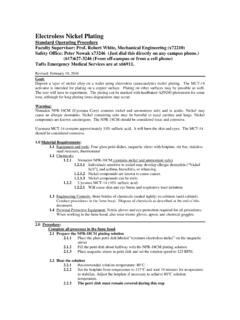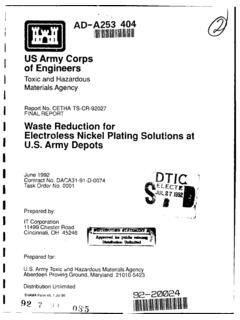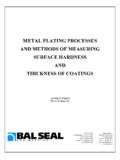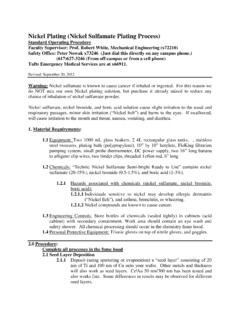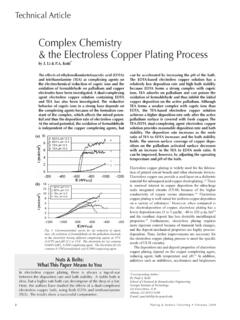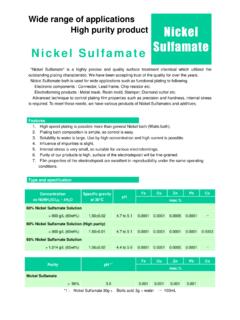Transcription of Nickel Electroplating* - CASF
1 1 Nickel electroplating * Contents Overview Decorative plating Engineering plating Electroforming Basics Basic Processes Hydrogen Evolution and Cathode Efficiency Anode Efficiency Nickel Ion and pH Changes Faraday's Law for Nickel Average Nickel Thickness Watts solutions and Deposit Properties Decorative Nickel plating & Multilayer Coatings Bright Nickel solutions Multilayer Decorative plating Microdiscontinuous Chromium Corrosion Performance Standards and Recommended Thicknesses Engineering & Electroforming Processes Watts and Nickel Sulfamate Processes Other solutions for Engineering Applications Nickel Alloy plating and Composites Quality Control Control Solution Composition Purification Techniques and Starting Up a New Bath Controlling the Main Constituents Controlling the pH, Temperature, Current Density and Water Quality Controlling Impurities Effects of Impurities on Bright Nickel plating Eliminating Rejects/Troubleshooting Controlling and Testing Deposit Properties Nickel Anode Materials Environmental, Health & Safety *Based on the article Nickel plating by George Di Bari in the ASM Handbook, Volume 5, Surface Engineering, published by ASM International, Materials Park, OH 44073, 1994, page 201, and reproduced with the permission of the publisher.
2 2 Overview The Nickel plating process is used extensively for decorative, engineering and electroforming purposes because the appearance and other properties of electrodeposited Nickel can be varied over wide ranges by controlling the composition and the operating parameters of the plating solution. Decorative applications account for about 80% of the Nickel consumed in plating ; 20% is consumed for engineering and electroforming purposes. Autocatalytic (electroless) Nickel plating processes are commercially important, but are outside the scope of this article. The annual worldwide consumption of Nickel for electroplating , including Nickel consumed as plating salts, is approximately 180 million pounds (81,700 metric tons), and accounts for 11 to 12 percent of world Nickel consumption. Decorative plating Modern decorative Nickel plating solutions contain organic additives that modify the electrocrystallization process so that mirror-bright, highly-leveled Nickel coatings are deposited directly from solution.
3 Prior to the introduction of the "organic" baths, decorative Nickel coatings were produced by polishing Nickel -plated parts mechanically, a practice that continued from 1870 to about 1945. Thin layers of chromium were electrodeposited over polished Nickel coatings for the first time in 1927 to prevent the "yellowing" or tarnishing of Nickel in outdoor atmospheres, and that practice continues with the as-deposited bright Nickel coatings now available. An effort to develop improved decorative, electroplated Nickel coatings began in the late 1940's and led to the development of multilayer Nickel coatings (early 1950's) and microdiscontinuous chromium coatings (mid-to-late 1960's). Modern multilayer Nickel coatings in combination with microdiscontinuous chromium are capable of protecting and enhancing the appearance of most metals and alloys, plateable plastics and other materials for extended periods of time.
4 Engineering plating The engineering applications of Nickel plating include those where a fully-bright appearance is not required. Engineering Nickel deposits are usually sulfur-free, and matte in appearance. These deposits may be specified to improve corrosion and wear resistance, to salvage or build-up worn or undersized parts, to modify magnetic properties, to prepare surfaces for enameling or for organic coating, to function as diffusion barriers in electronic applications and for other purposes. Engineering applications exist in the chemical, nuclear, telecommunications, consumer electronics and computer industries. Electroforming Nickel electroforming is electrodeposition applied to the manufacture of Nickel products of various kinds and differs from electroplating in one major respect. In electroplating , the coating is metallurgically bonded to the substrate and is an integral part of the surface.
5 In electroforming, Nickel is deposited onto a mandrel or mold non-adherently so that the Nickel can be separated from the mandrel when it is removed from the plating solution. Electroforming applications include the fabrication of molds and dies, mesh and other products that are indispensable to operations in the textile, aerospace, communication, electronics, automotive, photocopying and entertainment industries. 3 Basics Before describing decorative, engineering and electroforming plating processes, some basic facts are reviewed that make it possible to control the Nickel plating process, predict the amount of Nickel deposited and estimate Nickel coating thickness. The Basic Process Nickel plating is similar to other electroplating processes that employ soluble metal anodes. It requires the passage of direct current between two electrodes that are immersed in a conductive, aqueous solution of Nickel salts.
6 The flow of direct current causes one of the electrodes (the anode) to dissolve and the other electrode (the cathode) to become covered with Nickel . The Nickel in solution is present in the form of divalent positively charged ions (Ni+). When current flows, the positive ions react with two electrons (2e-) and are converted to metallic Nickel (Ni0) at the cathode surface. The reverse occurs at the anode where metallic Nickel is dissolved to form divalent positively charged ions which enter the solution. The Nickel ions discharged at the cathode are replenished by those formed at the anode. Hydrogen Evolution and Cathode Efficiency The discharge of Nickel ions is not the only reaction that can occur at the cathode; a small percentage of the current is consumed in the discharge of hydrogen ions from water.
7 This reduces the cathode efficiency for Nickel deposition from 100 per cent to 92 to 97 per cent depending on the nature of the electrolyte. The discharged hydrogen atoms form bubbles of hydrogen gas at the cathode surface. Anode Efficiency Under normal conditions the efficiency of dissolution at the anode is 100 per cent and no hydroxyl ions are discharged from the water. If the pH of the solution is too high, however, hydroxyl ions may be discharged in preference to the dissolution of Nickel , and oxygen will be evolved. Under those conditions, the Nickel anode becomes passive and ceases to dissolve Nickel . Activated Nickel anode materials are available commercially that resist the onset of passivity and replenish the solution with Nickel ions over a wide range of plating conditions.
8 Nickel Ion and pH Changes Under normal operating conditions, the Nickel ion concentration and the pH of the solution will slowly increase as plating proceeds. The rate of increase in Nickel ion concentration depends on the difference between cathode and anode efficiencies. Because cathode efficiencies may vary from 92 to 97 per cent, whereas anode efficiency is always 100 per cent, the rate of increase in Nickel ion concentration depends on the nature of the plating solution and not on the type of soluble Nickel anode material that is used. Faraday's Law for Nickel The amount of Nickel deposited at the cathode and the amount dissolved at the anode are directly proportional to the product of the current and time (Faraday's Law). The proportionality constant is equal to M divided by nF, where M is the molecular weight, n is the number of electrons involved in the electrochemical reaction, and F is Faraday's constant, equal to 96,500 4 coulombs (ampere-seconds).
9 For Nickel , the constant is grams per ampere-hour. That constant may be expressed in various units (see Tables 1A and 1B for useful facts and conversion factors for electroplating ). The constant for Nickel deposition is calculated assuming that cathode efficiency is 100%; since a small part of the current goes to discharge hydrogen, the constant must be adjusted by multiplying by the cathode efficiency; (for example, x = ). Faraday's Law for Nickel may be expressed as follows: m = (a) (I) (t) where: m is the amount of Nickel deposited at the cathode (or dissolved at the anode), in grams; I is the current that flows through the plating tank, in amperes; t is the time that the current flows, in hours; and a is the current efficiency ratio for the reaction of interest. In almost all cases, the anode efficiency is 100% (a = 1).
10 The cathode efficiency may vary from 92 to 97% and accordingly, a will vary from to Table 1A - Nickel electroplating facts Nickel Symbol Atomic Weight - Valency - Specific Gravity - plating Rate, at 100% cathode efficiency - Ni 2 g/Ampere-hour ( ) Nickel Sulfate NiSO4. 6H2O Contains Nickel . Nickel Chloride NiCl2. 6H2O Contains Nickel . Nickel Sulfamate Ni(NH2SO3)2 Contains Nickel . Nickel Carbonate NiCO3 Contains about 46% Nickel . Table 1B Units and conversion factors for Nickel electroplating Quantity A Traditional Unit B SI Unit To Convert from A to B Multiply by To Convert from B to A Multiply by Coating Thickness Mil Inch ?m mm Coating Mass (Weight) mg/in2 mg/in2 oz/in2 oz/ft2 g/m2 mg/cm2 kg/m2 kg/m2 Current Density A/ft2 A/ft2 A/in2 A/in2 A/m2 A/dm2 A/m2 A/cm2 1550 x 10-4 plating Rate A-hr/ft2-mil A-s/m2-?m 1530 Volume Gal Gal fl oz m3 Liter(L) Ml 264 Mass Concentration oz/gal g/L kg/m3 Volume Concentration fl oz/gal ml/L cm3/L Force (Internal Stress) 1000 psi MPa (Mn/m2) 5 Average Nickel Thickness The Nickel electrodeposition data compiled in Table 2 has been calculated on the assumption that cathode efficiency is , which approximates the case for most Nickel plating solutions .
